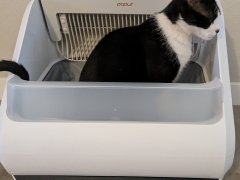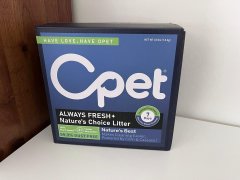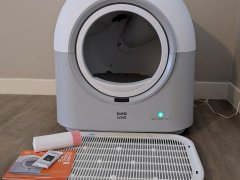
Liz Coleman & Mallory Crusta / Cats.com
When self-cleaning litter boxes first hit the market, those few early models weren’t perfect. But years of research and development, advances in modern technology, and consumer feedback have changed the game.
While Litter-Robot dominates the automatic litter box industry—and has become a household name among cat owners—there are other strong players on the field. CATLINK offers a suite of self-cleaning litter boxes that are similar to the popular Litter-Robot.
In this guide, we’ll dive into the details of these two popular options. In the matter of CATLINK vs. Litter-Robot, we can help you make the best choice for you and your cat.
About CATLINK
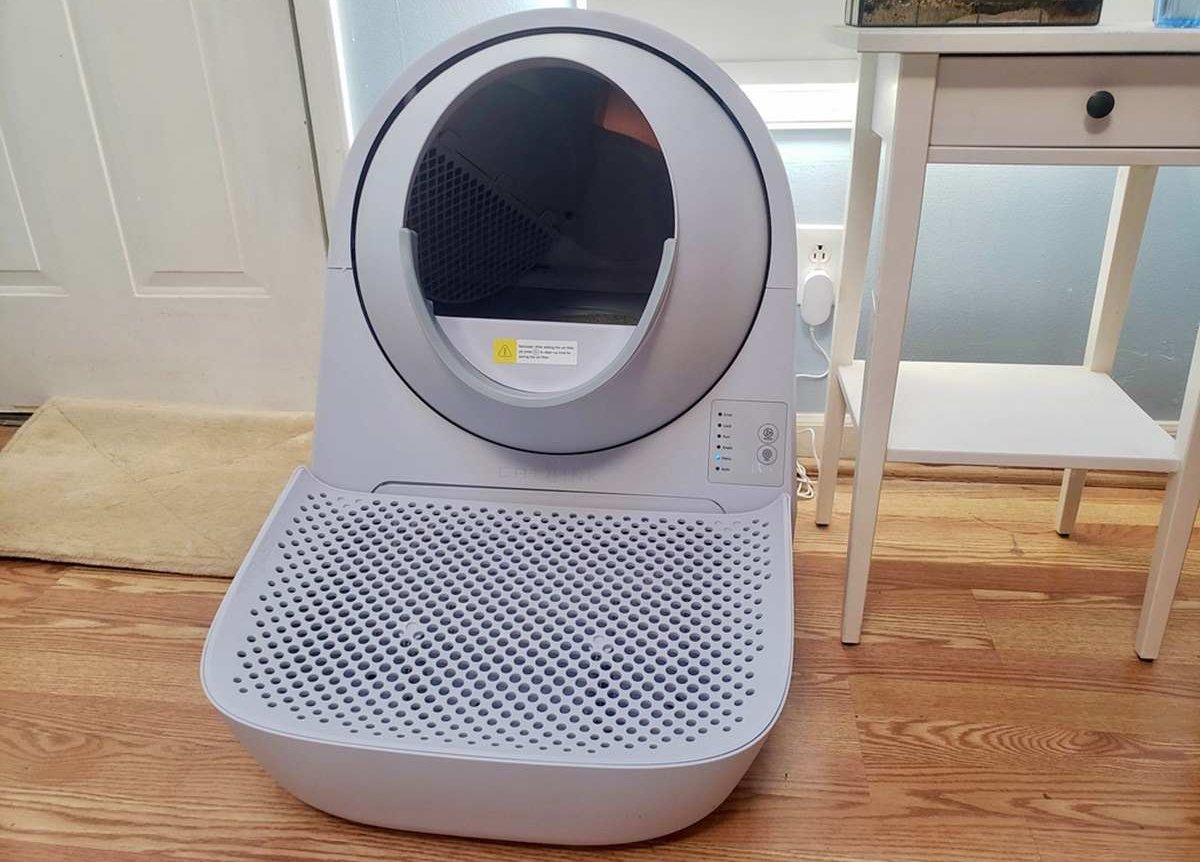
Liz Coleman / Cats.com
Ratings
- Ease of Cleaning – 4/5
- Appearance – 5/5
- Construction – 4/5
- Price – 3.5/5
- Customer Experience – 3/5
Overall Score: 3.9/5
Launched in 2017, CATLINK is a pet tech company headquartered in China. CATLINK’s products—which include an array of self-cleaning litter boxes, automatic feeders, and cat water fountains—are sold in over 40 countries.
The CATLINK lineup of automatic litter boxes includes three models:
- CATLINK Scooper Luxury Pro-X Self-Cleaning Litter Box
- CATLINK Scooper Young Pro-X Self-Cleaning Litter Box
- CATLINK Scooper SE Smart Litter Box
All three of CATLINK’s smart litter boxes utilize a sensor system that detects your cat’s presence in the litter box. When your cat is finished, the globe-like housing that makes up the bulk of the unit rolls back or rotates. With gravity doing most of the work, a built-in sifter separates waste from clean litter and deposits waste in a separate, sealed compartment to await disposal.
Like most automatic litter boxes, CATLINK’s models have a substantial footprint and a steep price. However, benefits like smart features, an intuitive setup process, and scoop-free convenience outweigh the drawbacks for many users.
About Litter-Robot
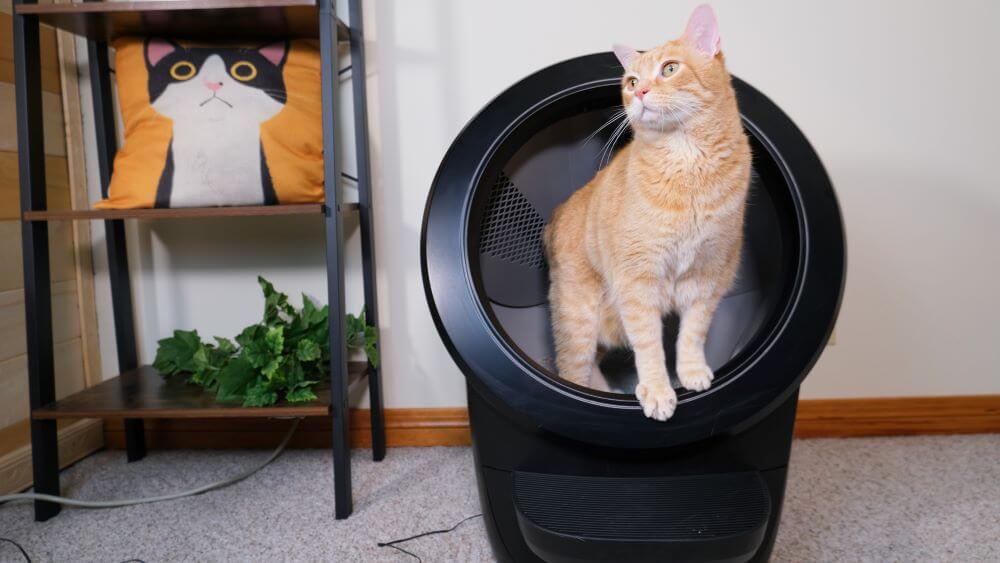
Mallory Crusta / Cats.com
Ratings
- Ease of Cleaning – 5/5
- Odor Control – 5/5
- Appearance – 5/5
- Construction – 5/5
- Price – 3/5
Overall Score: 4.6/5
The Litter-Robot is the flagship product for Whisker (formerly known as Auto Pets), one of the world leaders in automatic litter box technology. The first Litter-Robot was released in 2000. The fourth iteration of the Litter-Robot was released in 2022 after four years of development and remains one of the best-selling self-cleaning litter boxes on the market.
The following Litter-Robot models are still sold:
- Litter-Robot 4 Automatic Self-Cleaning Cat Litter Box
- Litter-Robot 3 Connect WiFi Enabled Automatic Self-Cleaning Cat Litter Box
Every Litter-Robot in Whisker’s lineup utilizes sensors to detect litter box activity and automatically initiate a cleaning cycle after use. Early models relied primarily on mechanical weight sensors, but the Litter-Robot 4 includes laser sensors for improved cat detection. Whisker has sold over 1 million units and its latest model has a strong track record of reliable performance and customer satisfaction.
Starting with the Litter-Robot 3 Connect, WiFi connections allowed users to track their cat’s usage and remotely trigger cleaning cycles. During a cleaning cycle, the globe rotates, sifting the litter to separate waste and depositing it in a sealed drawer in the unit’s base.
Size and Setup
While the details of form and function may vary among automatic litter boxes, most of them have one thing in common: they’re big. CATLINK and Litter-Robot are no different.
Both CATLINK Scooper models are similarly sized, while the Scooper SE is a little smaller. We tested the CATLINK Scooper Young Pro-X, which has a footprint of 23.5x23x28 inches and stands 28” tall. The Scooper Luxury Pro-X is a little deeper and has a slightly larger entry. Both units have a 57-liter globe capacity and weigh about 26 pounds.
Compared to both CATLINK Scooper models, the Litter-Robot 4 is a little narrower in body but has a wider entry. It measures 22” wide by 27” deep and stands 29.5” tall. The circular entry is 15.75” across and the unit weighs about 24 pounds.
The setup for the CATLINK and Litter-Robot is very similar and both units come fully assembled. Just plug them in, add your preferred clumping cat litter, and they’re good to go. You’ll need to download an app and connect the unit to your home’s WiFi to take full advantage of smart features. The CATLINK Scooper Young Pro-X is a simplified version— you just use the buttons on the control panel to make adjustments.
Operation and Performance
At a glance, CATLINK and Litter-Robot self-cleaning litter boxes work the same way. Both consist of a globe-like body set over a sturdy base that houses the waste compartment and all the electronics. Sensors detect your cat’s presence in the globe and the unit automatically cycles after they leave.
During a cleaning cycle, the globe rotates, sending the contents of the litter bed tumbling through an integrated sifter. While clean litter passes through the grate, clumps and solid waste slide through an opening in the globe and into the waste compartment in the base. As the globe returns to its original position, the waste compartment gets sealed off, and clean litter returns to the litter bed for the next use.
Both CATLINK Scooper models rely solely on mechanical weight sensors to detect your cat’s presence. The Litter-Robot 4’s OmniSense detection system includes mechanical sensors that detect weight as well as laser sensors that detect motion. In both, weight sensors also help track litter and waste drawer levels.
CATLINK and Litter-Robot units automatically stop if your cat enters the globe during a cleaning cycle, but the Litter-Robot’s system is more sensitive. Your cat doesn’t have to step into the globe to trigger the safety feature.
When it comes to performance, the Litter-Robot 4 has a strong reputation for reliability. It cycles without jamming and it’s easy to monitor the unit and view insights into your cat’s health via the Whisker app. Customer opinions on CATLINK’s performance are mixed; the brand doesn’t offer the same level of customer support if issues arise.
Cats who are used to using automatic litter boxes seem to adjust quickly to both CATLINK and Litter-Robot models.
The Litter-Robot is a little quieter than the CATLINK Scooper, and it has a built-in step that improves accessibility. CATLINK sells a separate step but the standard unit can be tricky for some cats to access easily. Overall, the Litter-Robot is a little larger and has a wider entry, which may make it a more comfortable choice for some cats.
Odor Control and Tracking
Because waste is deposited in a covered compartment in the base of the unit, both Litter-Robot and CATLINK models excel in odor control. Odor tends to be less of an issue with automatic litter boxes in general because waste doesn’t spend much time in the box.
CATLINK models have replaceable carbon filters at the front of the waste drawer to help eliminate odor. The brand also sells a separate smart deodorizer you can place in the waste drawer for additional odor control.
The Litter-Robot 4’s carbon filter is encased in a plastic cage that sits on top of the waste drawer, not inside it. When the globe is in its normal position, the filter cage effectively seals off the waste drawer—you can also add Whisker’s OdorTrap packets if desired.
Tracking seems to be an issue with both CATLINK and Litter-Robot models. Both utilize a litter-catching mat on the step, but their effectiveness appears limited. With the CATLINK, you only get this benefit if you purchase the add-on step.
Both the CATLINK Scooper and the Litter-Robot 4 have a shield across the front of the entry to help prevent your cat from kicking litter out of the globe. The shield helps a little in this department, but it contributes to a different issue. Some cats end up jumping in and out of the units instead of using the step, so litter doesn’t have a chance to get trapped by the mat.
Maintenance
To clean a CATLINK Scooper, you can activate the “empty” feature that dumps all the litter into the waste drawer. You can clean the globe with a damp cloth or take it apart for a deeper clean. The same is true for the Litter-Robot, but CATLINK models are a little more cumbersome to disassemble and reassemble.
In both cases, maintenance mainly involves refilling the litter bed and emptying the waste drawer. Both brands offer custom-fit waste liners to make emptying the drawer easy, though you can use any garbage bag that fits.
While both CATLINK and Litter-Robot units are easy to use and maintain on a day-to-day basis, it’s important to consider long-term maintenance. What happens when the unit stops working?
None of the Litter-Robots have been completely free from glitches, but replacement parts are easy to get and customer service is available by phone, email, or chat. Whisker also offers an extensive array of FAQs and troubleshooting videos. If you can’t solve the issue and your Litter-Robot is still under warranty, you may be eligible for a replacement.
Customer support for CATLINK is available by email and phone. CATLINK units come with a 1-year warranty and a 30-day return policy for products purchased directly from the brand. Numerous negative customer reviews mention issues contacting CATLINK support.
Cost
Automatic litter boxes aren’t cheap but if you’re investing in expensive pet tech, you want to get your money’s worth.
The Litter-Robot 4 is one of the most expensive automatic litter boxes on the market, priced at $699. Shipping is free in the United States (except to Alaska, Hawaii, and Puerto Rico). Black and white are the standard color options, though six other colors are available for a $50 upcharge. You can also upgrade the standard 1-year warranty to 3 years for $100.
The Litter-Robot 3 Connect is a little cheaper at $549. The same free shipping and 90-day in-home trial applies, as well as the warranties. Whisker also offers a wide range of accessories and furniture for the Litter-Robot.
CATLINK’s Scooper Young and Luxury Pro models are both $599 on Amazon but are frequently discounted. On CATLINK’s site, the Young model is $100 cheaper than the Luxury Pro. Both models come with a one-year warranty and free shipping.
Which Is Right for You?
If you’re looking for a litter box that eliminates the task of scooping with minimal setup, strong odor control, and app-enabled features, both the CATLINK and Litter-Robot fit the bill. All else aside, the most obvious difference is the price.
At full retail price, the Litter-Robot 4 costs about $100 more than the CATLINK Scooper Luxury Pro-X. That said, the small but significant differences between these two brands are worth considering if cost isn’t your primary concern.
Litter-Robot has a clear edge in engineering and sensor technology. The design has been fine-tuned over more than two decades to improve performance and resolve some of the minor complaints customers still have about CATLINK. Whisker also offers extended warranties and has strong customer support.
If the Litter-Robot 4 is a custom-tailored tuxedo, CATLINK is an off-the-rack suit. It checks all the boxes but it’s not a showstopper. Sometimes a comfortable suit is all you need.
The CATLINK self-cleaning litter box does what it’s designed to do and it’s more likely to be heavily discounted than the Litter-Robot. However, it might be too cramped for bigger cats and the step is sold separately. It might also be more of a hassle to take apart for deep cleaning or troubleshooting.
When it comes to the CATLINK vs. Litter-Robot debate, the verdict comes down to you and your cat. If you’re still not quite ready to decide, read our guide to buying automatic litter boxes.


